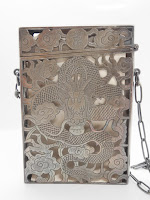The blog has moved!
Visit us at www.ninecarolineantiques.com for updated blog content
View this blog entry on the updated Nine Caroline Antiques website
Visit us at www.ninecarolineantiques.com for updated blog content
View this blog entry on the updated Nine Caroline Antiques website

Imagine a world where electronics ceased to exist and the handwritten letter was your main source of correspondence. It was not so long ago that this world existed. Unfortunately it is a pastime that many younger generations are clueless to understand. Not but one hundred years ago did society communicate through letters, cards, or simply word of mouth. During this era the calling card was like receiving a text, a way of saying “hello” to friends, family and loved ones. Although the calling card is now obsolete, beautiful ornate cases that once housed these cards are prized possessions and are collected by antique enthusiasts.
 The custom of carrying a calling card began in the early 1800’s in France. It was a popular trend among high society and soon spread throughout Europe and the United States. Each card was hand written, typically by talented calligraphers and then embellished by the bearer. Just as the cards themselves were decorative works of art so were the carrying cases. Many card cases were often small, just bigger than the cards to ensure ease of transport. Cases would hang from chatelaine belts or be tucked away in evening bags. Historically, cases were made out of silver, mother of pearl, bone, ivory and any other materials that were en vogue.
The custom of carrying a calling card began in the early 1800’s in France. It was a popular trend among high society and soon spread throughout Europe and the United States. Each card was hand written, typically by talented calligraphers and then embellished by the bearer. Just as the cards themselves were decorative works of art so were the carrying cases. Many card cases were often small, just bigger than the cards to ensure ease of transport. Cases would hang from chatelaine belts or be tucked away in evening bags. Historically, cases were made out of silver, mother of pearl, bone, ivory and any other materials that were en vogue.
These small elegant portfolios were carried by both men and women. A man's case was often less decorated and plainly designed because they were not as visible to the crowd. A simple design is not to disregard the man’s calling card which was often used to request a dance, or show interest in courting a young woman. A social endeavor that was necessary if you were outside the arranged marriages custom. However, it was the women’s cases that had engraved, embossed, carved, or even inlaid details. These are the cases that many collectors seek. Everything from floral bouquets, to figural designs adorned these cases.
It was proper etiquette to leave a card at the house you were visiting. Making social calls was a ritual, it was way to communicate. Every detail about the ritual was elaborate. The cards, the cases, even the trays or baskets where they were left in the entrance of the visiting home. The act of leaving a card was not only for the bearer of the card announcing their intent, it was also a way for other visitors to see who the household entertained at any given time, an act of social status.
The trend continued into the early 1900’s, although less popular by that time due to the invention of the typewriter and other printing devices. The once fashionable card soon turned into a businessman’s identification card. Although we carry business cards today they are not as elaborate, nor are they used in the same fashion. To blossom a romance or to request a dance are not traditional reasons to leave a business card in the 21st century. Collectors of calling card cases seek only the very best, most ornate, most unique designs found. Antique enthusiasts have been found using the cases for carrying modern day business cards. A case used today is a unique fashion statement with a sound historic social past.
The trend continued into the early 1900’s, although less popular by that time due to the invention of the typewriter and other printing devices. The once fashionable card soon turned into a businessman’s identification card. Although we carry business cards today they are not as elaborate, nor are they used in the same fashion. To blossom a romance or to request a dance are not traditional reasons to leave a business card in the 21st century. Collectors of calling card cases seek only the very best, most ornate, most unique designs found. Antique enthusiasts have been found using the cases for carrying modern day business cards. A case used today is a unique fashion statement with a sound historic social past.
Discover our fine examples of antique calling card cases, baskets, trays and accessories at our shop: NineCarolineAntiques!
